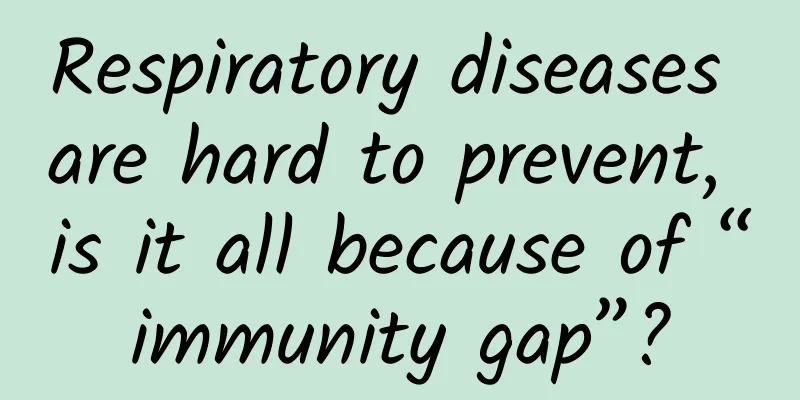Respiratory diseases are hard to prevent, is it all because of “immunity gap”?

|
At the beginning of the new year of 2020, in the face of the sudden outbreak of the COVID-19 epidemic, wearing masks became the first line of defense for people to jointly prevent the epidemic, and this self-prevention awareness is still retained by some people to this day. Today, it is the peak season for respiratory infectious diseases again - in fact, as early as the beginning of winter last year, a variety of respiratory diseases began to appear across the country, and many people began to wear masks again, even for a long time. Masks do help us reduce virus invasion. But at the same time, when the human body is in a state of strict social isolation for a long time, it is likely to lack immune defense against some respiratory pathogens . Does wearing a mask for a long time really reduce immune function? How can we improve our own immunity? Copyright image, no permission to reprint 01 Should I wear a mask or not? Wearing a mask is an effective measure to prevent the spread of respiratory diseases, but objectively speaking, it is not suitable for all situations and requires correct usage and reasonable time limits. First, wearing a mask correctly can effectively prevent the spread of droplets and viruses, reducing the risk of respiratory infectious diseases, which is especially important in densely populated areas or when in contact with infected people. Secondly, long-term wearing of masks can effectively prevent the invasion of viruses or bacteria and protect high-risk groups, such as the elderly, patients with chronic underlying diseases, and pregnant women. However, wearing a mask for a long time may bring some potential problems, and its pros and cons need to be viewed correctly: (1) Affecting breathing and gas exchange . Studies have shown that wearing a mask for more than 2 hours will affect breathing and cause discomfort in adults. This is because when wearing a mask, breathing resistance increases, and the wearer has to work hard to achieve gas exchange. The increased time of using the mask and excessive inhalation resistance affect breathing. In particular, the elderly, infants and young children are prone to hypoxia symptoms such as dizziness, chest tightness, and nausea due to poor breathing after wearing a mask. (2) The resistance of some people is reduced . This is because after wearing a mask for a long time, the body cannot breathe fresh cold air, which may cause mild hypoxia over time, which will reduce the body's ability to adapt to the natural environment, resulting in a decrease in the resistance of the nasal mucosa, sensitivity to the outside air, and a greater susceptibility to colds. (3) Facial skin infection . Wearing a mask for a long time without changing it can cause bacteria to grow. Improper storage of the mask, contamination with bacteria, and repeated friction on the face can cause the skin to be contaminated with mites, resulting in rough skin. In worse cases, it can cause facial skin allergies or even infections. Recently, the "Guidelines for the Public to Wear Masks to Prevent Respiratory Infectious Diseases (2023 Edition)" formulated and issued by the National Center for Disease Control and Prevention also explained that it is recommended not to wear masks in the following three situations or scenarios, including when doing physical exercise; when the risk of infection is low, such as in outdoor places such as open squares and parks; some people who are not suitable for wearing masks, such as infants and young children aged 3 years and under. Image source: National Center for Disease Control and Prevention 02 People can get infected even when wearing masks. Is the root cause of the abnormally high incidence of respiratory diseases due to “immune debt”? Respiratory diseases such as influenza come in waves every year, but this time is a little different. Since the autumn and winter of last year, mycoplasma pneumonia, influenza, syncytial virus, adenovirus, and many other infectious diseases have been rampant. Not only are pediatric clinics in hospitals across the country full, but adults have also begun to be infected. A considerable number of people have said that viruses are hard to prevent, and wearing masks can also cause "superimposed infections"... In addition, the proportion of the new coronavirus JN.1 variant has increased rapidly around the world, and everyone can't help but worry, is this intertwined "melee" of pathogens really because we owe an "immunity debt"? In layman's terms, "immunity debt" can also be called "immunity gap", but it is not a new term that has been coined recently. In the field of epidemiology, it refers to the lack of immune stimulation to pathogens after long-term intervention, which leads to a decline in herd immunity and an increase in susceptible people . Last November, the World Health Organization (WHO) and Nature both analyzed the causes of the surge in childhood respiratory diseases in China, believing that the "immunity gap" after the COVID-19 pandemic caused some children to lack immune defense against influenza, respiratory syncytial virus (RSV) and some other respiratory pathogens. Image source: https://www.nature.com/articles/d41586-023-03732-w The surge in the number of infected people in my country is not an isolated case. For example, the United States and New Zealand have seen a sharp increase in the number of RSV hospitalizations after opening up their policies. In addition to the increase in susceptible people caused by the immune gap, it is also related to the original epidemic cycle of the disease, and the superposition of multiple respiratory pathogens this year, all these factors have made this round of respiratory disease epidemic last particularly long. However, the term "immune debt" may be too narrow and inevitably lead to misunderstandings: Should we actively seek infection in order to gain immunity? 03 Improve immunity, active infection is not reliable! To some extent, wearing a mask for a long time will indeed prevent the immune system from functioning normally. However, at present, the scientific community generally does not recommend improving immunity through active infection . Once the human body is infected with viruses and pathogens, it may cause serious health problems or even endanger life. It is unwise to try to improve immunity through active infection, which is extremely risky. During the COVID-19 pandemic, some other countries adopted a more open policy, allowing some people to be infected naturally, and may have established a certain level of immune protection, but this level of immunity was formed at the cost of life. At the same time, the emergence of new mutant strains may bring about a new "immunity gap", and the practice of actively infecting to gain immunity to improve immunity has no scientific basis . The immunity gap is a group phenomenon. Improving the immune system should be achieved in a safe and scientific way, rather than through active infection. As individuals, in daily life, we should pay attention to healthy lifestyles and enhance immunity to better resist various diseases. This effect can also be offset by strengthening vaccinations, such as influenza vaccinations. Vaccines are a key tool for improving the immunity of the population. Even if there is no herd immunity in the population, widespread vaccination can provide protection at the individual level. Faced with the upcoming Spring Festival travel peak, masks are still an important tool for preventing the spread of respiratory diseases, and it is important to pay attention to the scientific and standardized wearing of masks. Make sure to wear them correctly, including covering the mouth and nose, sealing well, and avoiding touching the surface of the mask. And replace clean masks regularly. In addition, patients with chronic respiratory diseases need to take a series of preventive measures in the cold winter, including keeping warm, avoiding crowds, vaccination, regular medication, regular follow-up, and pulmonary rehabilitation training . Ultimately, global cooperation, scientific methods and vaccination, and attention to personal protection will be the key to defeating the virus and other new coronavirus variants. author: Li Nannan is a second-level researcher at the Hunan Association for Science and Technology, a director of the Hunan Science Writers Association, and an expert on popularizing science in China Yan Yusheng, Chief Physician of the Department of Respiratory and Critical Care Medicine, Changsha First Hospital, Chinese Science Popularization Expert Reviewer: Chen Yuefei, Researcher, member of Hunan Science Writers Association, expert on popular science in China Produced by: Science Popularization China Produced by: China Science and Technology Press Co., Ltd., China Science and Technology Publishing House (Beijing) Digital Media Co., Ltd. |
>>: For three hundred years, all things have been surging: this is Chang'an!
Recommend
Analyzing the hot-selling machine - the community ecology of Toutiao
As one of ByteDance's popular apps, Toutiao i...
Secret and hidden for a hundred years! What did Newton write in his manuscript?
Text|China Science Daily reporter Zhang Wenjing I...
The Information: ChatGPT's paid users exceed 20 million, OpenAI's annual revenue reaches US$5 billion
ChatGPT has more than 20 million paying users, an...
JD.com 618 Post-Battle Review: A Textbook Marketing Case
This year's 618 Mid-Year Shopping Festival fi...
Low Earth orbit space is a "big treasure"
Not long ago, after the successful launch of the ...
APP promotion: 9 strategies to open a restaurant at the lowest cost
Rental strategy 1: Travel during off-peak hours a...
How to operate Baidu Screen Domination? How to make money with Baidu screen domination promotion?
I've been busy with a project recently and ha...
Regarding Push operations, I have summarized 4 copywriting topics and writing skills
The writing of push title copy requires not only ...
Xiaohongshu’s complete promotion and operation plan!
At the beginning, my purpose of operating Xiaohon...
Why haven't we been destroyed yet?
© Video Hive Leviathan Press: When we expand our ...
Will QR codes be used up soon? Can genetic testing reveal your IQ? Which of these ten "scientific" rumors have you believed?
"QR codes will soon be used up", "...
Why does my voice sound so bad in the audio?
Since the introduction of voice services on socia...
Why are power banks allowed on airplanes but not allowed to be used? Here's what you need to know
Power Bank Travel Regulations The Civil Aviation ...
Inquiry on the investment price of Shijiazhuang Timber Mini Program. How much is the investment price of Shijiazhuang Timber Mini Program?
Starting a business requires costs, and mini prog...
Common traffic interception tactics for Internet marketing and promotion!
01Good content is the essence of traffic generati...









